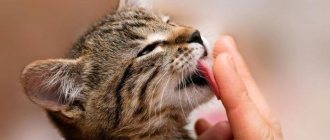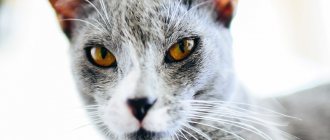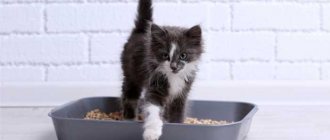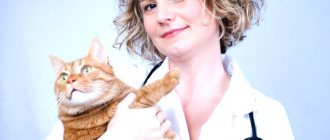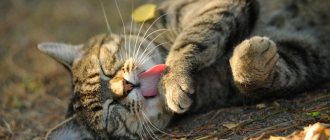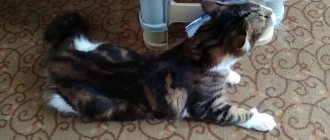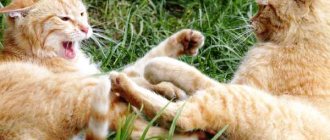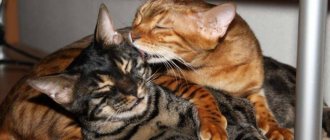Cats do not express their emotions as clearly as dogs. Sometimes cat behavior is difficult to interpret, but this does not mean that your pet will forever remain a mysterious creature for you.
The sounds he makes, body movements and everyday behavior will tell you how your furry family member feels. If you pay attention to them, you can not only learn to understand your pet’s personality traits and habits, but also see the slightest changes in his mood and health.
Meowing
An adult cat meows less often than a kitten, but in a very special way. If the tone is low, it means she is dissatisfied or unhappy for some reason. A high tone means she is in good spirits, and if the meowing is repeated, it means she wants your attention. You will soon learn to understand what your pet is “saying”: “let me go,” “feed me,” “caress me.”
Interestingly, meows are almost always directed at humans, and almost never at other cats. So listen - she is talking to you!
Eyes
A well-known saying goes: “the eyes are the mirror of the soul,” and this also applies to cats.
- The wide-open eyes of a pet tell the owner that the animal is showing curiosity.
- If they are half-closed, then there is nothing to worry about: the cat is relaxed, nothing bothers her, and she is enjoying life.
- Sharply dilated pupils indicate the animal’s fear: something scares it. It is in the interests of the owners to eliminate this as soon as possible.
- It's a bad sign when a pet looks into a person's eyes for a long time. If the cat does not close them and does not look away, then you should stay away from her - she may become aggressive.
- However, if a pet begins to slowly close its eyes, it means it is showing deep love for its owner. This behavior is called "cat kissing."
- When he simply looks away, the animal is afraid of a person, but recognizes him as a leader.
Talking Tail
A cat's tail perfectly reflects the mood of its owner. If the kitten is happy, the tail will be raised vertically. If he is scared, his tail will be tucked between his hind legs. If an adult cat swings its tail widely, it is a sign of irritation or impatience. If your cat is agitated, her tail will move quickly from side to side - this is a real threat. If your kitten's tail twitches, it means he is feeling admiration or curiosity.
Pricked ears are a sign of interest in what is happening around you. If the ears are straight and pointed forward, your cat is relaxed and friendly. But if she flattens her ears, this is a sign of aggression: you better retreat, otherwise you will be attacked.
Scratchy paws
Cats have long learned to use their front paws not only for movement and hunting. With their help, it is easiest for them to communicate with their owners. They have learned to give their paw when asked, or to touch their owner when attention is needed. Modern cats can even point in the direction or point to an object that interests them.
If, upon contact with a person, a cat clenches and unclenches its toes, retracting and pulling out its claws, then this means complete trust . Pussy loves the attention she gets. In this way she shows the owner to continue his actions.
If an animal hides its paws under itself while sleeping, it means the pussy is cold. Thus, the pet tries to maintain its body heat. To make your cat comfortable, you should buy a warm bed for him.
Your cat's habits: more and more curious
Without a doubt, cats have the strangest habits. Have you ever tried to unfold a newspaper and read it when your cat is nearby? She will immediately jump onto the table and settle down in the very center of your reading, and if only someone dares to move her! You won't be able to cheat and replace the newspaper with something else. Nor will you be able to persuade her to move to a much more comfortable pillow or chair. Why? Because while she is sitting on the newspaper, all your attention is focused on her.
If your cat rolls over onto her back and stretches out her paws, this is a sign of complete submission and trust in you. And also a demand for attention. And if she climbs onto your lap and curls up comfortably into a ball, this can hardly be interpreted other than contentment and calmness.
Sound signals
You'll learn a lot about your furry friend once you can understand his "cat vocabulary." Various “meows” and “murks” will tell you when the cat is hungry, bored, scared or in pain.
While some animals prefer to remain silent, occasionally breaking it with a short squeak, others are so “talkative” that they do not allow the owner to get a word in during the “conversation.” Kittens that have a lot of interaction with them when they are young often become sociable as they grow up. It should also be inherent in representatives of certain breeds; these include Siamese and Abyssinian cats.
If your furry friend is scared or feeling confused, he may meow frequently, asking for reassurance.
The number of sounds produced may increase with age. The causes are the development of dementia and visual impairment. Increased volume is often associated with hearing defects that prevent the animal from correctly assessing its voice.
Any changes in the frequency and strength of the sounds made by your pet require contacting a veterinary clinic to rule out the presence of diseases and pain.
- Meowing can serve a variety of purposes. These sounds are made by a cat as gratitude, demand, objection or notification. Some owners find their pets meowing while walking alone around the house (to themselves).
- The "chirps and trills" are used by the cat to get her cubs to follow her. In relation to a person, the animal uses the same sounds to direct the owner to the right place (mainly to a bowl of food). If several pets live in an apartment, you can often hear their active “iridescent” communication.
- Purring is usually a sign of satisfaction. Cats may purr when they are happy or even while eating. However, sometimes sounds indicate anxiety or illness and are a way of self-soothing (similar to children sucking their thumb).
- Growling and hissing indicate that the animal is experiencing irritation, fear, anger or aggression. If you hear such sounds from a cat, it is better to leave it alone.
- Screaming and howling (a loud, prolonged meow) signals that your pet is in a stressful situation (locked in the toilet, looking for you, or in pain).
Hearing such sounds, you need to find the cat and get rid of the problem. Unneutered male cats may howl during mating season. Older animals meow loudly and for a long time when they are disoriented, especially those suffering from cognitive disorders such as dementia. - Chatting and chirping are sounds made by cats while they sit on the windowsill and watch birds or squirrels. This is usually caused by being in an excited state (often due to the desire to snack).
The cat demands cleanliness
Cats are very clean animals. They don't like a dirty litter box and won't go into it. If their potty is a mess, then without the slightest remorse they can sit next to you and make a puddle right on the floor. But, as a rule, they will warn you in advance that you need to clean up.
In this case, my cats, for example, begin to deliberately loudly bury something in the pot. At the same time, they will not even touch the filler. They simply tap the edge of the tray with their paw and shout in displeasure. And this is no longer that affectionate “me” when they ask for food. No! This is clearly a curse word! You will realize that they will scream differently. For some reason, at such moments, it seems to me that they are telling me: “Man, come quickly to the tray!”
The cat is bored
Is the cat in a playful mood, not allowing you to pass, but at the same time bringing you toys, trying to make a toy out of you or out of your slippers? Throws her balls at your feet, climbs into your arms and doesn’t allow you to stare at your phone? She is bored. Play with her!
Cats play their whole lives. This is the most important component of their health, along with proper nutrition. Cats play even at a very advanced age. The truth, of course, is less. And for kittens this is simply vital for their good growth. For proper development of muscles, bones and joints.
Cats are social animals, and if you only have one, she may get bored. Then it is simply necessary for her normal mental health to sometimes play with her. Plus it will make you closer. And you will also receive a huge positive charge of vivacity.
You don't have to buy an expensive toy to play together. If you don’t have anything at hand at all, then take a piece of paper and a string. And you will see how much pleasure both you and your cat will have.
It is simply necessary for the normal mental health of a cat to sometimes play with it. © Gary Loewenthal
The cat is in pain
Your cat suddenly didn’t ask for food in the morning and didn’t even come out to you. And when you yourself offered her food, she did not pay attention to the food. Instead, it sits tensely on its belly, its fur is ruffled, and its pupils may be dilated. This is a sure sign that something is hurting her.
And it doesn't have to be the stomach. It could be anything. My cat once fell from the second floor and broke her leg, and she was sitting exactly the same way. Moreover, if they feel really bad, when you try to pick them up, they can be aggressive and even try to bite you. But you and I sometimes lash out at our family when we feel bad. Everything is like people.
So don't waste time, go to the vet. He will do tests, x-rays, ultrasounds and understand what happened to your cat.
The cat suddenly didn’t ask for food in the morning and didn’t even come out to you - she wasn’t feeling well. ©Ann Roberts
Other signs of an unwell cat
Here are some other signs when something is wrong with your cat:
The tongue is very strongly and constantly sticking out of the mouth . The cat doesn't clean it up at all. This is a very bad sign. As a rule, it speaks of some serious illness. This happened to me once with a cat. As it turned out, urolithiasis. I didn’t understand right away, and he fell into a coma. Thank God, everything is fine with him now, he was cured. But when you see this, don't hesitate.
also start coughing . This could be a sign of either worms, or, if the cat is old, a heart attack, or she could have choked on a thread, rain (from a Christmas tree) or something else.
If a cat vomits , as a veterinarian friend explained to me, up to two times is normal. Cats can swallow their own fur and then vomit. They can deliberately provoke vomiting, for example, by eating grass in the country. Sometimes on an empty stomach there may also be vomiting in the form of white foam. But when she vomits endlessly or vomits once, but you see blood there, or the vomit is unnaturally bright, yellow, like a marker, for example, this could be a sign of infection or some other disease. You should immediately contact a veterinarian.
If a cat shakes something . If she has a headache, for example, maybe her ears hurt. If it’s with her paw, then examine it carefully; she could have gotten hurt somewhere and it’s painful for her to walk.
If a cat has stopped licking itself , and before it was always clean, this is also a sign of ill health.
Making decisions
Whiskers raised forward and ears pressed to the head indicate that the cat is making a decision and is a little afraid of the possible consequences: stay in place or run? Should you go outside where it's raining or stay inside? In addition, when a cat is faced with a difficult choice, it waves its tail, as if swaying it. As soon as the decision is made, the tail will immediately calm down.
Do cats need human care?
Travelers rarely see small felines in the wild, where they survive and reproduce well in warm climates.
In urban conditions, with a long winter and a poor food supply, it is difficult for them to do without human help, even when there are warm basements.
Cats appreciate caring hands when people pick up helpless kittens from the street and offer to live in a common area. This is their home, they mean it that way, using curtains and sofas instead of trees.
They need to climb to keep their abdominal muscles toned. When there is no alternative in the form of special cat buildings, they “mischief” without malicious intent.
Abandoned food on the table is considered a hunting ground. They do not have the opportunity to independently obtain food within the four walls of the apartment.
Many people are interested in how to understand that a cat loves you. Pets often appear selfish and ungrateful while waiting for an opportunity to reaffirm their love for their owners. The animal greets you at the front door on its hind legs, stretches and lightly scratches the wallpaper.
Don’t rush to blame for the damaged interior; the gesture means “I love you and am very glad to come!” Punishment for scratching walls takes away the desire to show love and devotion.
Pet lovers say that the moments when a cat comes to “chug” and purr are priceless. Even if they don’t catch mice (well-fed cats are not interested), they delight their owners with their playful behavior.
Girls and catsWhy does a cat sneeze - diagnosis of the cause, treatment at home and tips for caring for cats with a cold (video + 110 photos)
A cat without water - how long can it live, features and possible consequences of dehydration (125 photos)
If a pet catches mice and crushes rats, this does not mean that it does not need to be fed. But how can we understand the behavior of cats if they bring “prey” into the house?
They are probably demonstrating that it is not for nothing that they eat their “bread” or offer to share.
Some experts argue that with their prey they show people the shortcomings of their diet. There were cases that in times of famine, animals began to carry caught sparrows and pigeons into the house, feeding their emaciated owners.
Today, this behavior is difficult to understand, seeing carefully laid out bears on the doorstep or a strangled rat on the pillow. Accept that they are also capable of taking care of us if they consider it necessary, animals are waiting for approval...
Let's understand a cat by its sounds
At least 16 sounds are used by cats to communicate . Different cat breeds differ in their talkativeness. Siamese and Oriental cats love to chat with their owners the most. Rumbling and purring are characteristic of small cats. A cat's purring is a symbol of sympathy for its owners and good disposition. By purring, a cat shows its aggressiveness and tells you that it is ready to start a fight; Hissing shows fear and uncertainty about salvation. When a cat is contemplating fight or flight, it snorts and leans its body forward.
Happy and relaxed
When your cat is relaxed and happy, he may appear sleepy. His head is motionless, only his eyes move. A cat who appears relaxed and content may easily accept your petting and hugging.
Ears
Relaxed cat ears will be in a natural position. They will not be flattened towards the head or tilted back. Although their ears may twitch in response to noise, they do not turn constantly.
Eyes
When the cat is relaxed, his pupils will be normal size. You can see them half closing their eyes as if he is about to fall asleep. He won't seem wary.
Body
If your cat is lying down, she can lie on her side, at an angle so that her belly is visible. This is a sign that he feels safe. If your pet is sitting, his back will be straight and his head raised.
Tail
A happy, relaxed cat will allow its tail to stretch out and tuck. The tail will be fairly motionless, and the fur will adhere to it.
Purr
Surprisingly, scientists have not yet discovered the mechanism of cat purring. How it happens and why is not known for certain; there are only assumptions. A cat's purring differs in volume, intensity and nature of the sounds produced by the cat. Interestingly, kittens at the age of two days can already purr. With this signal the cat:
- Shows pleasure. Most often, cats purr with pleasure when they are caressed and stroked.
- Attracts attention. If your cat purrs and rubs her legs, you can rest assured that she probably wants you to feed her or pet her.
- Trying to calm down. It has been established that rumbling provokes the production of a special hormone in cats, which has a calming, relaxing and analgesic effect. So a cat can purr even when sick or in fear.
How to calm a cat during spring?
The second way to calm an anxious pet in the spring is to give your cat special “anti-sex” pills during the period of heightened instincts. You can find them in almost every veterinary pharmacy. The drugs are divided into two groups: herbal drugs and hormonal tablets.
Interesting materials:
What does a heart tattoo mean? What does a heart tattoo on the shoulder mean? What does an elephant tattoo mean? What does an infinity sign with a feather tattoo mean? What does a panther tattoo on a leg mean? What does a Cerberus tattoo mean? What does it mean to match you? What does it mean that technical support by phone has expired? What does a current account on a card mean? What does it mean that the subscriber’s phone is temporarily unavailable to Tele2?
What do cat poses tell you?
A terrifying pose: the cat, with its tail bent and its back arched, stretched its paws forward and stood on tiptoes. The fur stood on end, the ears pressed to the back of the head, the nose wrinkled, the fangs were exposed. This pose is accompanied by rumbling and snorting. If the cat is frightened, the nodules on its cheeks move and the fur bristles.
The pose of peace and bliss is expressed as follows: in a relaxed state, the animal lies on its back, opening its belly. In this case, the eyes are half-closed, the paws are spread out to the sides, the claws are hidden, and the pads are compressed and unclenched. This is how the cat speaks of complete trust in you, because its stomach is the most unprotected place. If, playfully, she suddenly hides her head in a secluded place, then she says: “look for me, I’m hiding.”
If, when stroking the lumbosacral region of the back, the cat falls on its front paws, lifts the back of its body and moves its tail to the side, this means that it wants intimacy with the cat.
You can find out more detailed information about how to determine the behavior of cats by their tail and what different poses mean in this article.
Photo tips on how to understand a cat
Read here Why cats are afraid of water: how to teach them to bathe, features of the lifestyle of cats and the main reasons for their fear of water (90 photos)
Help the site, share with friends 
Muzzle and mustache
Not everyone knows, but cats have very expressive facial expressions. This helps some owners find a common language with their pets.
- Antennae pointing forward indicate increased interest in something.
- If the pet spreads them apart, it means he is calm.
- Those lowered indicate melancholy or possible illness of the animal.
- If a cat presses its whiskers to its cheeks, it means something is bothering it.
- Fluffy pets like to rub their cheeks on various objects - this is how they mark their territory. This also applies to the owner: the cat shows that he is now her property.

